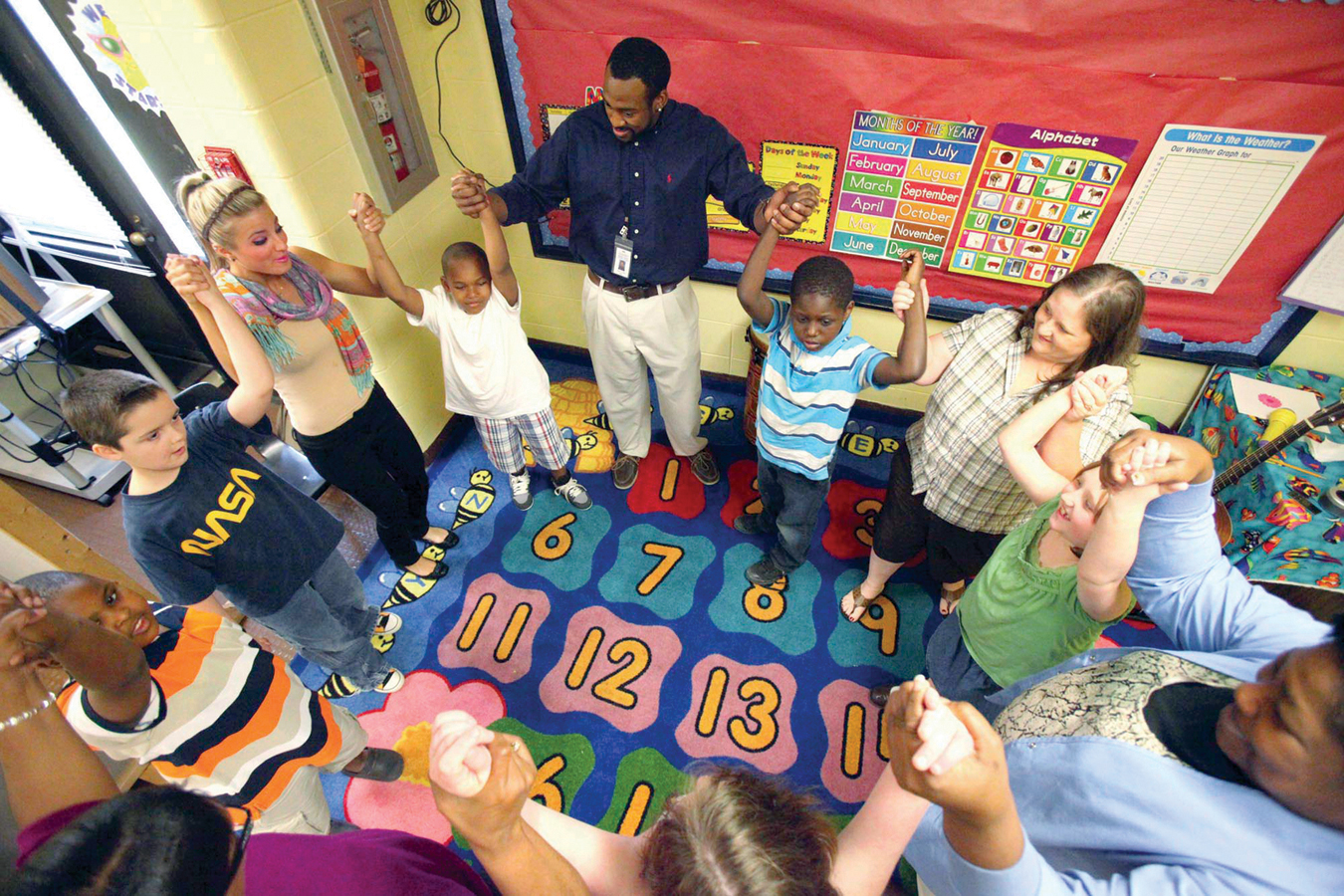7.5 Children with Special Needs
Many children have learning patterns that respond best to targeted education. Although some differences among children are harmless, others indicate disorders that need to be recognized to help children learn. Before leaping from diagnosis to special education, however, we need to understand three concepts: comorbidity, multifinality, and equifinality (Cicchetti & Toth, 2009).
Many disorders are comorbid, which means that at least two problems occur in the same person. A child may need special help to overcome one problem, but that help needs to take into account other problems that the child might have.
Multifinality means that one cause can have many (multiple) final manifestations. The same genes or past trauma may produce a child who is easily angered (conduct disorder) or quick to cry (major depression).
Equifinality (equal in final form) means that one symptom can have many causes. For instance, a 6-
To illustrate all three concepts, we focus here only on attention deficit and bipolar disorders, learning disabilities, and autism spectrum disorders.
Attention Deficit Hyperactivity, Bipolar, and Disruptive Mood Dysregulation Disorders
Attention deficit hyperactivity disorder and bipolar disorder are discussed together because they are often comorbid and confused with one other (Miklowitz & Cicchetti, 2010). Disruptive mood dysregulation disorder is a new diagnosis that helps resolve this confusion.
Attention Deficit Hyperactivity DisorderPerhaps 10 percent of all young children have attention deficit hyperactivity disorder (ADHD), which means they have difficulty paying attention and may also be filled with uncontrollable urges to be active or to act out impulsively. A typical child with ADHD, when made to sit down to do homework, might look up, ask questions, think about playing, get a drink, fidget, squirm, tap the table, jiggle his or her legs, and go to the bath-
278
The number of children diagnosed with ADHD has increased in recent decades. For instance, the rate of diagnosis in the United States has increased from 5 percent in 1980 to about 10 percent currently. The rate has doubled in Europe as well (e.g., Hsia & Maclennan, 2009; van den Ban et al., 2010). About twice as many boys as girls have ADHD (National Center for Health Statistics, 2011).
Diagnosis is a problem, since some adults are quick to blame children’s (especially boys’) behaviour on a disorder. Experts say that ADHD should be diagnosed only when it is apparent in at least two places (e.g., home and school) and when it does not improve with consistent structure and guidance. A first step is for parents and teachers to learn how to provide that guidance (Subcommittee on ADHD, 2011).

Bipolar DisorderBipolar disorder is characterized by extreme mood swings, from euphoria to deep depression, that are not linked to external circumstances. Children with bipolar disorder experience at least one episode of grandiosity. They might believe, for instance, that they are the smartest person in the school, a genius destined to save the entire world. At other times, the same child might be severely depressed, unwilling or unable to read, play, or go to school (Miklowitz & Cicchetti, 2010).
One U.S. study reported that medical visits for youth under age 18 with a primary diagnosis of bipolar disorder increased 40-
OPPOSING PERSPECTIVES
Drugs for Children
ADHD is the most common diagnosis for children in North America. Using psychoactive drugs to treat children with ADHD and other disorders, such as depression, anxiety, developmental delay, autism spectrum disorder, and bipolar disorder, is a highly controversial but widespread practice. For example, In Canada, prescriptions for antidepressants among children increased by 75 to 80 percent between 1997 and 2003 before tapering off, partly in response to Health Canada’s warning of a possible increase in suicide attempts by users of paroxetine, a particular type of antidepressant (Mitchell et al., 2008; Oberlander & Miller, 2011). Before the drop-
The drug most commonly prescribed in middle childhood is methylphenidate, sold under the name of Ritalin and used to treat ADHD. Ritalin is a type of drug known as a psychostimulant. It may seem odd to prescribe a stimulant to children who are already hyperactive, but Ritalin stimulates the brain to cause the release of the neurotransmitter dopamine, which allows the executive centre of the brain in the prefrontal cortex to function in a normal fashion.
Much of the North American public is suspicious of any childhood psychiatric medicine (dosReis & Myers, 2008; McLeod et al., 2004; Rose, 2008), partly because many have been inadequately tested for children and are prescribed “off label”—they have not been approved for patients of that age or for the particular condition for which they have been prescribed. That suspicion affects attitudes toward drug use for children.
One small study of parents whose children were diagnosed with ADHD found that about 20 percent believed drugs should never be used for children (dosReis et al., 2009). A large study found that only about half (56 percent) of the parents of U.S. children who are diagnosed with ADHD give them medication every day (Scheffler et al., 2009).
279
The opposite perspective comes from professionals who find that medication helps schoolchildren with emotional problems, particularly ADHD (Epstein et al., 2010; King et al., 2009; Scheffler et al., 2009). Many educators and psychiatrists consider it tragic that only half of the children diagnosed with ADHD take medication of any kind for it (National Center for Health Statistics, 2011). They argue that if a child had Type 1 diabetes, parents would give insulin; so, logically, when a child has an emotional illness, parents should give medicine if it helps.
Some parents agree with that perspective. The same study that found 20 percent of parents were always opposed to drugs also found 29 percent who believed that drugs were necessary and who blamed doctors for waiting too long to prescribe (dosReis et al., 2009).
Although many drugs help children with their immediate problems, the long-
- Will children who take drugs become adolescent addicts?
- Will height be stunted?
- Will medication cause other psychiatric disorders?
The answer to all three is no, according to scientific longitudinal studies. In fact, childhood medication for children who are unable to function normally reduces the risk of later illegal drug use and of other disorders, and does not make children shorter than their genes destined them to be (Biederman et al., 2009, 2010; Faraone & Wilens, 2003).
The rate of developing another psychiatric disorder is compared not with the overall average, but with the rate in children who have the same initial psychological problems but are not medicated. This is important because the incidence of pathology for young children who have special needs is higher than average, no matter what treatment they are given (Geller et al., 2008; Loe & Feldman, 2007; Molina et al., 2009).
There is another issue, however. As more drugs are prescribed, more abuse of those drugs occurs. Ritalin in particular is sometimes taken illegally by teenagers who want an extra boost (Setlik et al., 2009). Either they get the drug from someone who actually has ADHD, or they pretend to have ADHD themselves, or they buy it illegally.
Finally, although many children benefit from drug use in the short term, there is scant evidence that long-
As you see, neither side has all the evidence in its favour. Since psychoactive drugs, taken daily from childhood on, add to the profits of drug manufacturers, some people suspect that money contaminates the research. No one disputes that, when children have special needs, parents and teachers need support and training. People on both sides also agree that drugs are not a lifelong solution. Whether short-
Disruptive Mood Dysregulation DisorderAlthough professionals agreed that the rapid increase in the rates of childhood bipolar disorder were a result of misdiagnoses, they could not ignore the fact that many children were being brought to pediatricians and psychologists by parents (or referred by teachers) because they were too often rageful and irritable, even on their best days. These weren’t just children going through a difficult phase, but children who were chronically angry, and whose behaviour was occurring at home, at school, and for months on end. The new edition of the DSM-
Distinguishing Between DisordersBipolar disorder is extremely difficult to differentiate from other psychiatric illnesses in youth (Phillips, 2010). Many children diagnosed with either ADHD or bipolar disorder may be more accurately diagnosed with the other. It is hoped that the new DMDD diagnosis will result in more accurate diagnosis and effective treatment.
280

Both ADHD and bipolar disorder are more common in children whose parents have a disorder, sometimes the same disorder as the child. Parents of children with ADHD often have learning disabilities, whereas parents of children with bipolar disorder are likely to have mood disturbances. This suggests a genetic link as well as multifinality.
Both disorders are related to unusual brain patterns. Children with either disorder are less able than the average child to distinguish emotions when looking at faces. That much is true for both disorders, but activation of distinct parts of the amygdala differs between the two (Brotman et al., 2008, 2010).
Treatment involves (1) counselling and training for the family and the child; (2) showing teachers how to direct attention and increase structure to help the children learn; and, if that does not help, (3) medication to stabilize moods for bipolar children and to calm children with ADHD. Ongoing monitoring is crucial because some drugs help children with ADHD but harm those with bipolar disorder. In addition, each child responds differently to each drug, and responses change with time.
Specific Learning Disorders
The DSM-
Data from the 2002/2003 National Longitudinal Survey of Children and Youth (NLSCY) reported that about 4 percent of Canadian children from 8 to 11 years of age were diagnosed with a learning disability in 2002 (Milan et al., 2006). The most commonly diagnosed learning disability is dyslexia, unusual difficulty with reading. No single test accurately diagnoses dyslexia (or any learning disability) (Riccio & Rodriguez, 2007).

Early theories hypothesized that visual difficulties—
A decade ago, dyslexia was diagnosed when a child’s reading achievement was far below that child’s intellectual potential—
281
Dyscalculia is unusual difficulty with math. The root cause is neurological, and although dyslexia and dyscalculia can be comorbid, each is a separate disorder originating from a different part of the brain, and each requires targeted education (Butterworth et al., 2011). Often computer programs as well as various auditory and visual treatments help. One strategy that is not effective and that can, in effect, be dangerous is simply waiting for a child to outgrow a learning disability. Many children who have learning problems develop behaviour problems as well.
Autism Spectrum Disorder
Of all special needs children, those with autism spectrum disorder (ASD) are perhaps the most troubling, not only because their problems are severe, but also because the causes of and treatments for ASD are hotly disputed. Most children with ASD can be identified in the first year of life, but some seem quite typical at first and then display signs of the disorder later on.
The Centers for Disease Control and Prevention (CDCP) report that ASD affects about 1 in every 88 children in the United States (three times as many boys as girls and more European-
SymptomsThe two signs of autism spectrum disorder are (1) problems in social interaction and the social use of language, and (2) restricted, repetitive patterns of behaviour. Children with any form of ASD find it difficult to understand the emotions of others, which makes them feel alien, like “an anthropologist on Mars,” as Temple Grandin, an educator and writer with ASD, expressed it (quoted in Sacks, 1995). Consequently, they do not want to talk, play, or otherwise interact with anyone, and they are especially delayed in developing a theory of mind (Senju et al., 2010).
Some children with autism spectrum disorder never speak, rarely smile, and often play for hours with one object (such as a spinning top or a toy train). Others are called “high-
282
Far more children have ASD now than in 1990, either because the incidence has increased or because more children receive the diagnosis. You read that currently in the United States about 1 child in 88 has ASD. Some other estimates put the number even higher—
TreatmentSome children with ASD are on special diets, take vitamin supplements, or are on medication. One drug in particular, risperidone, relieves some symptoms (although research finds side effects, including weight gain), but no biochemical treatment has proven successful at relieving the disorder itself. As you already know, medication use is controversial: Whether a child takes risperidone depends on many factors other than symptoms (Arnold et al., 2010; Rosenberg et al., 2010).

Some parents of children with ASD reported that they first noticed their infant’s lack of social responses after vaccinations and believe thimerosal, an antiseptic containing mercury that was once used in immunizations, was the cause. No scientist who examines the evidence agrees: Extensive research has disproven this hypothesis many times (Offit, 2008). Thimerosal was removed from vaccines a decade ago, but the rate of ASD is still rising.
Doctors fear that parents who cling to this hypothesis and forgo routine vaccinations for their children are not only wrong, but are also harming millions of other children. Indeed, in North America, the 2012 rate of whooping cough was higher than in any year since 1960. Babies younger than 2 months have died of whooping cough because they are too young to be immunized and because older children whose parents do not vaccinate them spread contagious diseases.
One popular treatment for ASD is putting the child in a hyperbaric chamber to breathe more concentrated oxygen than is found in everyday air. Two studies of hyperbaric treatments—
Many behavioural methods to improve talking and socialization have been tried, with mixed results (Granpeesheh et al., 2009; Hayward et al., 2009; Howlin et al., 2009). Many clinicians use a mix of behaviour analysis, sensory play, and communication therapy to help children with ASD develop imaginative play, cognitive flexibility, and an understanding of the feelings of others. Early and individualized education of the child and parents sometimes succeeds, although special education is not a panacea, as you will now see.
283
Special Education in Canada
Developmentalists are well aware that physical, cognitive, and psychosocial development interact to affect each child’s behaviour. That means doctors, parents, teachers, and policy-
Changing PoliciesIn the past in North America, children with disabilities were educated in separate schools or classrooms, if at all. Starting in the 1960s, in Canada and the United States, school administrators and government officials began to recognize that all students had the right to be educated in a common environment. One groundbreaking piece of legislation was the 1975 Education of All Handicapped Children Act in the United States, which stipulated that children with special needs must be educated in the least restrictive environment (LRE) (Edmunds & Edmunds, 2008). This national law meant that every state in the country had to adjust its educational practices in regard to children with disabilities.
In Canada, even though there is no federal department of education, every province and territory has adopted policies that to a large extent mirror those of the U.S. law when it comes to instructing children with special needs in an LRE. Most of the time, this has meant placing these children with other children in a regular class, also called “mainstreaming,” rather than in a special classroom or school. Sometimes children are sent to a resource room, with a teacher who provides targeted tutoring. Other times, students attend an inclusion class, which means that children with special needs are included in the general classroom, with appropriate aids and services (Kalambouka et al., 2007). TABLE 7.4 describes how provincial and territorial departments of education define the concept of an LRE in their respective statements of philosophy regarding the education of students with special needs.
| Province or Territory | Description of LRE |
|---|---|
| Alberta | “… regular classrooms in neighbourhood schools…first placement option.” |
| British Columbia | “… equitable access to learning by all students.” |
| Manitoba | “… students with special learning needs in regular classroom settings.” |
| New Brunswick | “… with same- |
| Newfoundland and Labrador | “… programming is delivered with age peers except where compelling reasons exist.” |
| Northwest Territories | “… whenever possible, access to an education program in a classroom setting.” |
| Nova Scotia | “… within regular instructional settings with their peers in age.” |
| Nunavut | “… equal access for all students to educational programs offered in regular classroom settings with their peers.” |
| Ontario | “… integration as the first consideration.” |
| Prince Edward Island | “… most enabling environment that allows opportunities to interact with peers.” |
| Quebec | “… a view to facilitating their learning and social integration.” |
| Saskatchewan | “… students with exceptional needs…should experience education…in inclusive settings.” |
| Yukon | “… in the least restrictive and most enabling environment to the extent that is considered practicable.” |
| Sources: Edmunds & Edmunds, 2008; Saskatchewan Education, 2000. | |
284
A recent strategy in both Canada and the United States is called response to intervention (RTI) (Fletcher & Vaughan, 2009; Shapiro et al., 2011). All children who demonstrate below average achievement are given some special intervention. Most of them improve. For those who do not, more intervention occurs. Only if repeated intervention fails is the child referred for testing.
Professionals use a battery of tests (not just IQ or achievement tests) to decide whether a child needs special education. If so, they discuss an individual education plan (IEP) with the parents to specify educational goals for the child. The IEP goes by different names in different parts of Canada: individual program plan (IPP) in Alberta and Nova Scotia; personal program plan (PPP) in Saskatchewan; and individual services support plan (ISSP) in Newfoundland and Labrador. However, the intent and format of the document is similar from province to province. According to the Ontario Ministry of Education, an IEP is
a written plan describing the special education program and/or services required by a particular student. It identifies learning expectations that are modified from or alternative to the expectations given in the curriculum policy document for the appropriate grade and subject or course, and/or any accommodations and special education services needed to assist the student in achieving his or her learning expectations.…The IEP is not a daily lesson plan itemizing every detail of the student’s education.
Teaching strategies to assist students with disabilities may include using special resources such as videos, audiotapes, and simplified reading materials. Accommodating students includes giving them extra time for their tests or assignments, or assigning them scribes to take notes for them in class (Ontario Ministry of Education, 2000).
Prevalence and AccessSince there is no federal department of education in Canada, this country lacks statistics on the overall number of students with disabilities. However, reports from the United States have revealed two important statistics:
- The number of students receiving special education services has increased every year since 1976–
1977. - In 2010, the number of 3-
to 21- year- olds being served by special education was about 13 percent of the student population.

285
Most experts think that similar trends and statistics apply in Canada (Edmunds & Edmunds, 2008). According to a 2006 Statistics Canada Survey, learning disabilities, which include ADHD and dyslexia/dyscalculia, are by far (81 percent) the most frequently reported condition requiring special education services (Kohen et al., 2006). In specific populations, rates of learning disabilities can be higher. For example, a report on students with special needs in First Nations schools in British Columbia concluded that almost one-
Cultural DifferencesDevelopmentalists consider a child’s biological and brain development as the starting point for whatever special assistance will allow each child to reach full potential. Then home and school practices are crucial. In regard to access to special education services, almost one-
At times, the problems parents experience in getting what they consider necessary services for their children have erupted into national controversies. Consider the case of Jeffrey Moore, a child with dyslexia attending a British Columbia grade school in the early 1990s. Every week in Grade 1, Jeffrey received two 40-
These are North American controversies. Other countries have quite different policies and approaches toward special education. For instance, in Finland almost every child is recognized as having some special educational needs, but almost no child is labelled or removed from the class for that reason. Instead, every teacher works to help each child with his or her special needs (Sahlberg, 2011).
Gifted and TalentedQuestions surrounding access and funding are also apparent for the 2 percent of school-
In the past, such children were simply put ahead a grade or more, but that left them socially isolated. One gifted student remembers:
Nine-
[Rachel, quoted in Freeman, 2010]
Lifelong problems occurred for this girl partly because she skipped two grades. She still thinks it might have been her fault that she was a weed, not a flower.
286
Currently, the most common solution for gifted children is to teach them all together, either in a separate classroom within a school or in a separate school, such as the Westmount Charter School in Calgary, Alberta, which caters exclusively to the gifted. Ideally, the children are neither bored nor lonely because each is challenged and appreciated. Their brains develop as well. A child’s brain is quite plastic, and all children learn whatever their context teaches.
Some parents, however, experience problems in trying to place their children in gifted programs, even when the children have been assessed as gifted. Access problems are especially evident in times of financial restraint. During economic recessions, governments often cut education funding, and school boards in turn look for staff and programs to cut. Gifted programs, like special education programs, often suffer from these financial cuts.
Another issue that has repeatedly dogged gifted programs is their perceived tendency to favour students from higher-
Such concerns are not abstract. One Canadian report indicated that in the Ottawa-
Difference as the RuleScholars all find “much heterogeneity and diversity of high human potential in terms of varied developmental niches, trajectories, and pathways” (Dai, 2010). With so many complexities, some nations and school systems avoid special education of the gifted, or of any child with special needs, at least until high school or post-
China insists that effort, not innate ability, leads to excellence, and thus all children are educated together. In many nations of Asia and Africa, every child is expected to help his or her classmates, so separating out gifted students or those with disabilities would undercut education. This sometimes occurs in North America as well. For instance, Fern Hill School, a private school with campuses in Oakville and Burlington, Ontario, no longer assigns the gifted designation to any of its students. When asked why, one school administrator stressed that all children have talents (Pearce, 2012). A leading U.S. educator suggests that we
give up the notions of ‘the normal,’ ‘the disabled,’ and ‘the gifted’ as they are typically applied in schools, especially for the purposes of classification and grouping, and simply accept difference as the rule.
[Borland, 2003]
Considering development in body and mind during middle childhood, differences abound—
287
KEY Points
- Emotional and behavioural disorders in childhood are difficult to diagnose and treat, in part because of multifinality and equifinality.
- In diagnosis of special needs, bipolar disorder is often confused with attention deficit hyperactivity disorder, although the treatment for the two differs.
- Learning disabilities are common, with dyslexia and dyscalculia being problematic in school.
- Children with autism spectrum disorder have difficulty with social interaction, language, and creative play.